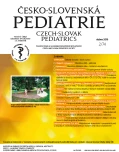Physical activities in the prevention and therapy of childhood obesity
Authors:
D. Pastucha 1,2; F. Chmelík 3; H. Canibal 4; M. Dabrowska 1; A. Struhalová 1; P. Konečný 5; J. Pařízková 6
Authors‘ workplace:
ReFit Clinic, s. r. o., Olomouc
1; Ústav rehabilitace, Lékařská fakulta, Ostravská univerzita, Ostrava
2; Institut aktivního životního stylu, Fakulta tělesné kultury, Univerzita Palackého v Olomouci, Olomouc
3; Dětské oddělení Nemocnice s poliklinikou, Havířov
4; Ústav fyzioterapie, Fakulta zdravotnických věd, Univerzita Palackého v Olomouci, Olomouc
5; Endokrinologický ústav, Praha
6
Published in:
Čes-slov Pediat 2019; 74 (2): 102-105.
Category:
Overview
Physical activity is one of the basic biological manifestations and needs of human life. Due to the lack of adequate space for natural active movement and preference for sedentary leisure time there is a reduction in leisure time activity, a decrease in the level of physical fitness, an unfavorable intake ratio and energy delivery. One of the most serious consequences of lack of physical activity is obesity. However, the lack of movement is very negative and more complex.
Physical activity as one of the health-related behavioral components of young people is important in terms of public health and prevention of the development of cardiovascular, metabolic, endocrine and other civilization diseases in adulthood.
Keywords:
obesity – body mass index – Physical activity
Sources
- Sigmund E, Sigmundová D, Badura P, et al. Temporal trends in overweight and obesity, physical activity and screen time among Czech adolescents from 2002 to 2014: A national health behaviour in school-aged children study. Int J Environ Res Public Health 2015; 12 (9): 11848–11868.
- Pastucha D, et al. Pohyb v terapii a prevenci dětské obezity. Praha: Grada, 2011 : 1–128
- Kučera M, Dylevský I, Kolář P. Dítě, sport a zdraví. Praha: Galén, 2011 : 1–190.
- Pařízková J, Lisá L, et al. Obezita v dětství a dospívání: terapie a prevence. 1. vyd. Praha: Galén, Karolinum, 2007 : 1–239.
- KapangiI IA. The Physiology of the joints. Vol. III. The Trunk and the Vertebral Column. 2nd ed. Edinburgh & London & New York: Churchill Livingstone, 1974.
- Pařízková J, Maffeis C, Poskitt EME. Management through activity. In: Walter B. Child and Adolescent Obesity: Causes and Consequences, Prevention and Management. West Nyack, USA: Cambridge University Press, 2002.
- Sigmund E, Sigmundová D, Badura P, Madarasová Gecková A. Health-related parental indicators and their association with healthy weight and overweight/obese children’s physical activity. BMC Public Health 2018; 18 (676): 1–11.
- Sigmundová D, Sigmund E, Badura P, et al. Parent-child behavioural patterns related to pre-schoolers’ overweight/obesity. Acta Gymnica 2017; 47 (2): 53–63.
- NASPE (National Association for Sport and Physical Education). Active start: A statement of physical activity guidelines for children birth to five years. Reston, VA: National Association for Sport and Physical Education Publications, 2009.
- Timmons BW, Naylor PJ, Pfeiffer KA. Physical activity for preschool children – how much and how? Appl Physiol Nutr Metab 2007 : 32 (Suppl 2E): 122–134.
- Dygrýn J, Mitáš J, Gába A, et al. Changes in active commuting to school in Czech adolescents in different types of built environment across a 10-year period. Int J Environ Res Public Health 2015; 12 (10): 12988–12998.
- Beighle A, Pangrazi RP. Measuring children’s activity levels: The association between step-counts and activity time. J Phys Act Health 2006; 3 (2): 221–229.
- Jago R, Watson K, Baranowski T, et al. Pedometer reliability, validity and daily activity targets among 10 to 15 years old boys. J Sports Sci 2006; 24 (3): 241–251.
- Pate RR, Davis MG, Robinson TN, et al. Promoting physical activity in children and youth: A leadership role for schools. Circulation 2006; 114 (11): 1214–1224.
- Tudor-Locke C, Ainsworth B, Thompson RW, Matthews CE. Comparison of pedometer and accelerometer measures of free living physical activity. Med Sci Sports Exerc 2002; 34 (12): 2045–2051.
- Pařízková J. Impact of education on food behaviour, body composition and physical fitness in children. Br J Nutr 2008; 99 (Suppl 1): S26–S32.
- Pařízková J, Hills A. Childhood Obesity. Prevention and Treatment. 2nd ed. Boca Raton – London – New York – Washington: CRC Press, Taylor and Francis, 2005 : 1–544.
Labels
Neonatology Paediatrics General practitioner for children and adolescentsArticle was published in
Czech-Slovak Pediatrics

2019 Issue 2
Most read in this issue
- Overweight and obesity among children aged 7–8: Results of the WHO project in Slovakia
- Obesity and hypertension in children
- Etiopathogenesis of childhood obesity
- Obezita v dětském věku – historie a současnost
